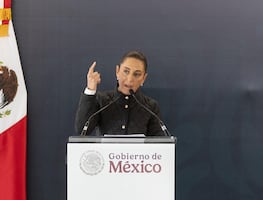Más Información

“Vamos a dar apoyo a los pequeños agricultores por sequía en Sonora”; Claudia Sheinbaum instruye a Berdegué

Derrota de México en disputa por maíz transgénico contra EU; estos son los argumentos de Sheinbaum y AMLO para prohibirlo

Óscar Rentería Schazarino, ha operado contra CJNG, Viagras y Templarios; es el nuevo secretario de Seguridad en Sinaloa

Claudia Sheinbaum pide respeto para Maru Campos; gobernadora anuncia acuerdo para transporte público

Claudia Sheinbaum anuncia los Centros de Cuidado Infantil en Chihuahua; inaugura hospital en Ciudad Juárez
Every year on January 6 , children from several regions in Latin America and Spain eagerly await the arrival of the Three Wise Men , who bring gifts, candies, and toys to reward them for their good behavior.
“The festivity begins the previous night when kids release their helium balloons or leave a list with their suggestions in a shoe,” says Victor Ruiz, anthropologist at the National School of History and Anthropology. “This festivity is the representation of a Biblical passage, in which three wise men from the East visit Mary and Joseph to see the new king, the one who got away from Herod. The toys and presents we see nowadays symbolize the offerings these characters gave to baby Jesus .”
However, the passage of time has caused the original tale to change and has given birth to several myths. Below you can find some of the more popular ones and the truth about them.
1. They were three
“Although we know the tale of the three magi kings who visited baby Jesus to give him gold, frankincense, and myrrh, we cannot be sure there were only three people who brought offerings to the new king,” says Victor Ruiz.
“According to Mathew's Gospel, we have a record of the Magi Kings and it is only said they came from the East but we don't know how many they were.”
2. They were magi
One of the greatest mysteries is why the Kings – or Wise Men – were known as “Magi”.
“The reason is that a magus, in Biblical times, wasn't a sorcerer but someone who possessed a vast knowledge of science,” explains the anthropologist, “their knowledge on astronomy guided them to Jesus.”
3. The origin of their names
According to the tales, the Three Wise Men , named Melchior, Caspar (or Gaspar), and Balthasar, traveled a long distance following the stars and orders of the angels to visit the new king, Jesus. However, the names don't come from the Bible, they weren't even written by St. Mathew.
“The first time the Wise Men were given a name was in a text called Liber Pontificalis , during the 9th century, which is a recollection of anecdotes and biographic documents of ancient Popes,” says Víctor Ruiz.
4. The constellation of the Three Wise Men
At least once in our lives, our parents made us look above, into the night sky, and asked us to find the Three Wise Men . We were able to see three bright starts, almost perfectly aligned, which we all assumed were the Wise Men. Yet, this is the constellation of Orion, known as Orion's Belt.
“It's common to say the stars are the Three Wise Men because of the number of stars we can easily see when we look up,” states the anthropologist.
Did the Star of Bethlehem really exist?
5. The festivity
January 6 isn't only the day when kids receive gifts, it's also the day when Mexican families eat the traditional Rosca de Reyes ( Three Kings' Day Bread or Three Kings' Bread ). Nevertheless, the importance of the date isn't only because of the Biblical passage of the Three Wise Men, it's because of the Epiphany.
“This is an important date because, in addition to the presents (which are toys nowadays) that baby Jesus received, we have the [religious] festivity of the Epiphany : the revelation of Jesus before the entire world, linked to the visit of the Three Wise Men to Mary and Joseph.”
am





